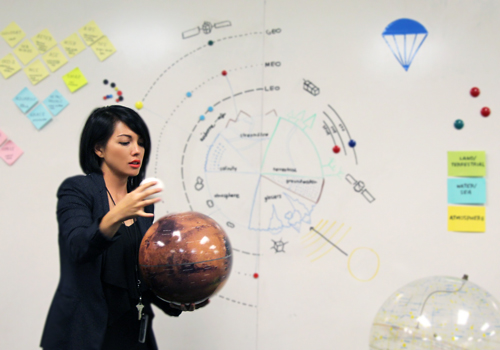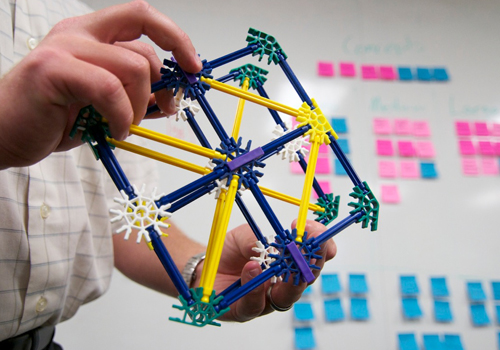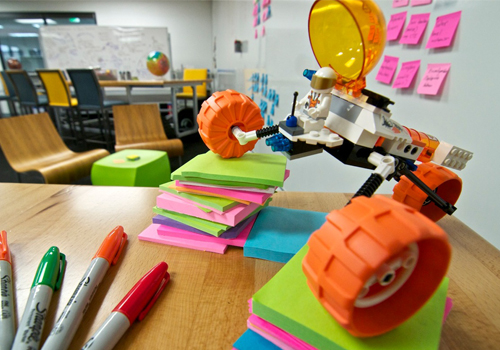
Jessie Kawata applies design thinking to scientific quandries at NASA + JPL
Jessie Kawata (BFA, Product ’11) is a Visual Strategist at NASA’s Jet Propulsion Laboratory, where she gets to stare into space for a living. This term she is teaching a Saturday High class at Art Center as well as mentoring students in Product Design’s Design for Sustainability 2 Studio class, which includes a NASA JPL theme using JPL’s Earth Mission and Climate Sciences data. Below she describes how she helps pave the way for design to exist in space exploration.
THE LAUNCH
“Welcome Aboard,” said the Executive Assistant of NASA’s Jet Propulsion Laboratory as we were looking out from one of the highest floors in JPL. In that surreal moment, I felt like I had truly left my home planet of design and boarded a spaceship. With no clear destination, an unknown trajectory—and only one other Design Earthling in sight—I knew I had an important mission ahead of me. I was to go on a journey of planting art and design seeds into the universe of astrophysicists, planetary geologists, engineers and scientists of all kinds.
I soon learned that NASA, although appreciative and familiar with art, was quite unfamiliar with the true value of design, and how it can impact the infrastructure of JPL. Sure artists and designers can help communicate complex scientific and engineering concepts to the public, but we can also help their thinking process. I knew I had to be an advocate not just for design, but also for design-thinking, process, research and strategy. But where in the JPL universe can a product designer have a big impact?

Left Field is where creative ideas grow at Nasa + JPL
THE JOURNEY
“Encourage wild ideas. Defer judgement. Build on the ideas of others.”
These 3 phrases are written above the wall-to-wall whiteboards in Left Field, NASA JPL’s Rapid Mission Architecture Room. In this space, this type of thinking is a part of rocket science. Literally. Packed with sticky notes, sharpies, prototyping tools and illustrations of purple spacecraft, Left Field is one of the most colorful places at JPL. This is a place where space mission ideas are born. The brainstorms that flow through this space have the maturity of what JPL refers to as a “napkin sketch.” Left Field brings JPLers of all different disciplines together into intense workshops or design sessions that last anywhere from three hours to two days.
Left Field is led by the core A-Team, a group of systems engineers and scientists who facilitate, lead and build tools for these sessions. Similar to Art Center “DesignStorms,” the world of Left Field and rapid mission formulation felt oddly familiar to me. I knew that this is where I could inject design thinking. I soon became the only creative designer that has ever been a member of the core A-Team. The pressure was on.

Modeling creative storytelling in a mission architecture session at NASA + JPL
THE DESTINATION
“How do we get into the caves of Mars?”
“What parts of our solar system can we study with this new spectrometer?”
“What do we need to fly through the plumes of Enceladus?”
These are the types of questions that come up in our early mission architecture sessions in Left Field. Mapping out the science and mission architectures of these big questions is definitely a daunting and tedious task. Telling the story of a complex mission or science concept is always a great challenge. It is extremely easy for people to get lost in the details. Design can step in and help mission teams to take a step back and see the bigger picture. Through the help of design thinking, data visualization, creative strategy and rapid prototyping, scientists and engineers can better communicate and evaluate these intricate systems. My role as lead creative designer in the core A-Team is not only to help facilitate these studies, but to design new tools and creative methodologies to boost the productivity of mission formulation.

Post-it notes litter ideation sessions in JPL’s Left Field
THE ARTONAUTS
Although half of the week I’m in Left Field, covered in sticky notes with crazy scientific words and acronyms, my mothership is actually a little creative design studio up the hill. Led by Dan Goods, it is NASA’S first creative design studio to house a team of designers and artists. In three years, our studio has grown to six Design Earthlings. We are known for helping JPL think outside-the-box, whether through exhibits, data visualization, outreach campaigns or interactive installations. In true spirit, we’ve become science storytellers: bringing emotion back into the galactic world of robots, planets, asteroids, and spacecraft.
THE FUTURE
The future for design at NASA is most definitely promising. Even though design may not be expanding at the speed of light; it has surely reached new frontiers in a short time. It is possible that art and design will be integral to JPL’s infrastructure and become adopted across the entire laboratory very soon. My hope is that one day JPL can lead by example and convince NASA as a whole of the value of design. Until then, our little design spaceship is working hard to reach the depths of other galaxies at JPL, paving the way for future “Artonauts” to follow.








